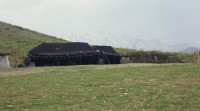 Photo.
Photo.
Approaching a camp with Bakhtiari nomads.
Later this day in the afternoon, a man from a Bakhtiari-group showed up on a
top of a hill by a waterfall, and started to talk to me. My excellent guide Ali
translated everything for me, and this man had many interesting things to
tell. He invited us to meet his family whom live up in a hill nearby.
See the video clip from the brutal Choopy-dance (click on this link): Choopy-dance.
Seasonal
wandering
When we arrived we were immediately welcomed. Soon they
started to serve me tea and ask about me. I told them I came from a country
where there lived nomads: the Sami (the laps) in Norway. They were also eager to
hear about the agriculture and pasture conditions my country.
|
Photo. Bakhtiari men in their traditional
costumes.
My guide Ali sits at the right side. I and him had a real good
conversation with the men. |
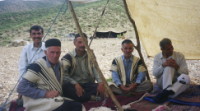 |
The tribesmen told me that their religion was
Shiite (Shiite Muslims). Some of the men took the religion very seriously. They
had a strong belief, and they like to follow traditions in many ways.
They told me also that they wandered over 500 kilometres each season. Some parts
of the distance the women and children were going by buses, but the men had to
walk in order to take care of their cattle. At this place they arrived in the
winter there was a small school for the children.
Arranging of marriages
An elder man said he would kill his
daughter if he noticed that she talked to a stranger. As I could see from his
cold stone face, he really meant it seriously. Some groups (clans) or families
could be fanatic in some ways, but that it's their culture and way of life.
The parents find the marriage partner to their sons and daughters. They make
a deal with the other partners parents. Usually they marry with someone within
the group. Before the finale decision is made the parents or represents for
their parents sit in a tent together with a Mullah to discuss the marriage.
|
Photo. Nice
people who had many interesting things to tell.
They were really proud of their culture.
|
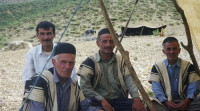 |
Ancient sites in the wild landscape
The next day we were
visiting some cemeteries. Some of the graves were disturbed by looters, but
fortunately most graves were intact.
The tribesmen I had met so far told me about unexcavated sites nearby,
one of the places was called Hosistand, where the sites were not fully excavated
or not excavated at all. Some sites have been exposed for looting so there were
not much left, but it was still some few interesting things to look for.
Bakhtiaria`s ancient objects are only found in cemeteries around in the area.
| Photo. Lion sculptures in a Bakhtiarias`s cemetery
symbolise braveness. |
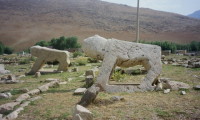 |
Actual the Iranian lion were little bit smaller than the African lion, and
was extinguished for over 80 years ago.
|
The Bakhtiaria`s cemeteries around in the area are very beautiful, but
it looked as they were exposed for looters. Photo. Big
holy grave in a Bakhtiaria`s cemetery, with a hand that stretch against
the sky. |
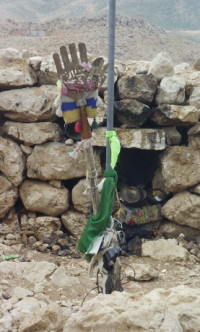 |
The hill with natural resources
Later on the day we
visited another Bakhtiari-group on a hill. At this hill it was so much
natural resources that it had to be a real natural wonder! I assumed that the
people who lived there they must be really rich. Did they understand how
valueable these resources could be?
Threats in the grass
Also here I had to walk up a barren
hillside. I was so focus of the beautiful view that I forgot about other things,
but as I knew Iran has some dangerous animal warriors. On my way up to the camp
the tribesman warned me by about a snake in the short grass. I didn't notice it,
but I it reminded me about Iran's four extremely poisoned snakes. Since I didn't
see it I am sure it crawled back to its burrow. There were also scorpions and
lizards in the area, the tribesman told me. These creatures are so well
camouflaged that it's almost impossible to spot them.
Photos. Bakhtiari nomads live in a beautiful scenery, but in
the grass there could hide some nasty creatures.
I wouldn't like to encounter some of these bizarre creatures. That would
probably cause me a nightmare. And it didn't make me more relaxed when I started
to think of that these predators probability were nocturnal. Where was it safe
to sleep? I had heard about that female scorpions eat their partners after
mating, and sometimes even before. For males who like to mate take a big risk:
it can end their relationship with the female or even worse: his life! The Wind
Scorpions in Iran are very ferocious with big and strong jaws: this specimen of
scorpions is so fast as they seem to fly like the wind. That's why they have got
this name.
Fight(s) for land
Our local guide from the group told us
that he has been fighting with his uncle about the land. His uncle fired 5 shots
against him. One of them hit him and injured him seriously as we could see on
his leg. The tribesmen I met around maintained that they had legal weapon. It
was for hunting and defending themselves, they said.
It's sad to see so many tribe people live on an existing minimum struggling
to maintain their lifestyle and culture. The government prosecute anyone hunting
endangered animals without the permitted hunting period. Hunts are conducted in
a strict secrecy. Now it's maybe too late for this because many species of
animals, as for example the lions and tigers, are already extinguished. It's few
left of others. It's said that it's still few panthers and leopards in the deep
forests. Perhaps there can be some pumas around in the high mountains too, but
they are difficult to spot.
The tribesman went to a kind of court in the tribe, but he didn't get support
from the so called jury. The men just said that his uncle was little bit
confused and didn't mean to harm him.
We were guided around in vulcanic landscape. Here we found incredible natual
resources. There were several minerals that we believed could be very
valuable for the land owners, and the land owners were the family group
we visited.
|
Photo. My guide Ali (right) talks with a nomad
about the salt spring.
Hopefully the salt and the other natural resources at this hill could
create a better future for this nomadic group we visited. |
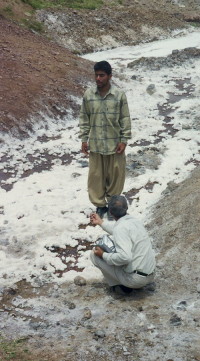 |
|
Photo. This was the main salt spring where the nomads
collected the salt.
The heat was tremendous, but it didn`t stop the brave nomads from
working. But no pain, no gain! |
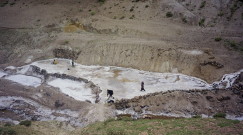 |
How bigger families affects the nature
For 20 years ago
there were one family. Now it is about 50 members in his group. So when the
people increase in number, land will not be sufficient for all of them, and then
the problems occur. It's the same with the cattle. They need more cattle to
sustain the people, and if the pasture fields are not big enough, they have to
buy expensive food for the animals.
The population have grown fast the last 10 years. Earlier they had up to 10
children in a family. Now they have 3-4 children in a family. More people mean
more land to share and harder exposure on the nature. One person said that the
ecological system will collapse within 10 years, and he feared that it will
cause a disaster for the people.
Our nice guide from this nomadic group also invited us to his wedding few
days later, but unfortunately we didn't have time to go there. We wished him
good luck, and hope now that he is a happy man.
More adventures
My guide Ali told me that it would be
better day for day according to our itinerary. The adventure has just been
started, he said, but I really wondered how it could be better than this. You
will see, he said, and as always Ali kept his promises. The rest of the tour
became an unforgettable adventure in a country that everything could happen!
Read more about the nomads in Iran: especially the warrior
Choopy-dance: sometimes it hit your leg with a big bang, but sometimes
even worse: it can hit your knee and then it can be really serious. It must
be the world`s most brutal dance!
Stein Morten Lund, 8 August 2004
Additional information
See the video clip
from the brutal Choopy-dance (click on this link): Choopy-dance.
Facts about Iran:
Formal country name: Islamic Republic of
Iran.
Area: 1.64 million sq km.
Population: 68.27 million.
People:
Persian (Farsis) (65%), Azari (25%), Arab (4%), Lors (2%), Turkmen (2%),
Kurdish, Armenian, Jewish.
Language: Persian, Kurdish.
Religion: Shi'ite
Muslim (89%), Sunni Muslim (10%), Zoroastrian, Jewish, Christian, Baha'i
(1%).
Government: Islamic republic.
****************************************************************************************************************
Pars
Tourist Agency (P.T.A.), Iran
Presentation:
It`s a
private Persian incoming agency. It's located in Shiraz under the license
number 1/47026 issued by Iran Travel & Tourism Organization (ITTO) (www.farstourism.org). They organise a wide
variety of tours for individuals as well as groups such as inbound historical,
cultural, anthropology, mountaineering, trekking, adventure and natural
excursion tours.
Speciality - exploring nomad tribes:
For real adventurers P.T.A.
arranges expeditions in to rural areas to search for nomad tribes in Iran's high
mountains. Some of the tribes are Bakhtiari, Lor, Qashqai. They live in a
beautiful landscape that will take your breath away. You will be able to explore
the tribe's daily life and unique culture in a natural way. Sometimes you will
experience a wedding, birth, fighting game, dancing, festival or other things.
Take your time and see what happens. Then it will be an experience of a
lifetime.
Contact info:
Phone: 0098-711-2223163 and 0098-711-2240645. Mobile
Phone (around the clock) 0098-9171118514.
Fax: 0098-711-2229693
Letters:
Pars Tourist Agency (P.T.A), Zand Street 71358, Next to Iran Cinema, Shiraz,
Iran.
Website: www.key2persia.com
E-mail: info@key2persia.com
****************************************************************************************************************
